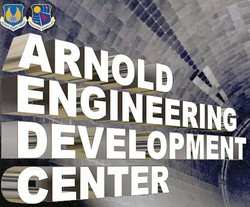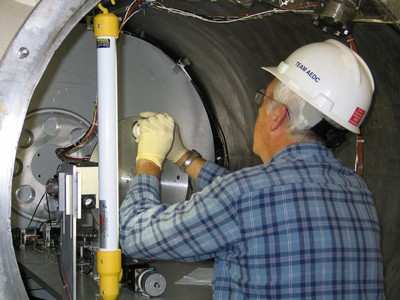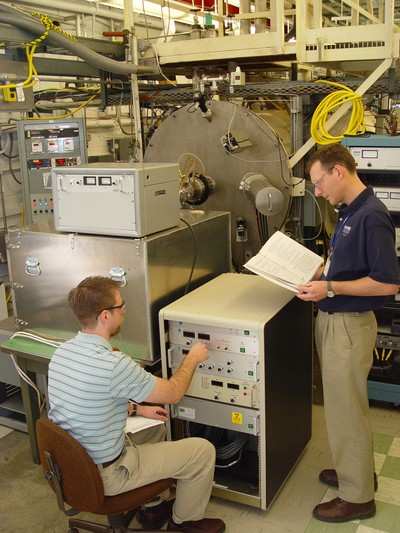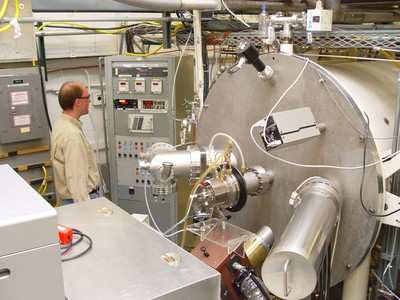Specialized Equipment Simulates Conditions In Orbit
 The US Air Force's Arnold Engineer
Development Center (AEDC) scientists and engineers are leading the
way in finding solutions on Earth to complex problems satellites
can encounter in space. A team at the center's space chamber
research lab has conducted the first system checkout for the lab's
Characterization of Combined Orbital Surface Effects (CCOSE)
chamber in its most advanced configuration to date.
The US Air Force's Arnold Engineer
Development Center (AEDC) scientists and engineers are leading the
way in finding solutions on Earth to complex problems satellites
can encounter in space. A team at the center's space chamber
research lab has conducted the first system checkout for the lab's
Characterization of Combined Orbital Surface Effects (CCOSE)
chamber in its most advanced configuration to date.
"Very few, if any, ground testing facilities have specialized
space simulation chambers with the range of capabilities we've
incorporated into this one at AEDC," said John Prebola, an
Aerospace Testing Alliance (ATA) project manager at the space
chamber research lab. "This chamber will save our customers money
and help them provide reliable, long-term performance of systems
that many of us rely on every day."
Tests conducted during the system checkout involved subjecting a
solar cell and a sample of thermal control paint to conditions that
are found in space.
The area above and beyond Earth's atmosphere is known to be
punishing on components on the outer surface of satellites and
other spacecraft orbiting Earth or transiting through the solar
system. These components, which include solar cells, thermal
control surfaces and optics, require a clean environment to operate
properly and continue to function. They are also vulnerable to
factors such as charged particles, solar radiation, outgassing
(release of gas from materials used to build satellite components)
and contamination from thrusters.
"Even small amounts of contamination, solar radiation or atomic
oxygen can seriously degrade the performance of these components
and has caused multiple spacecraft (system) failures over the
years," explained Dustin Crider, a physicist in ATA's Technology
and Analysis Branch. "The more frequent problems we encounter in
space are often due to a combination of these factors or what's
known as a synergistic effect."

Air Force research Laboratory (AFRL), NASA and spacecraft
manufacturers have a standard approach to space materials
development.
"They create batches of new materials with varying
characteristics and test how these materials respond to one or two
aspects of the space environment at a time," Prebola explained.
"These results are combined in computer models to predict how
hardware built from these new materials will perform in space."
Limited ground tests are performed at different stages of the
development cycle as hardware and subsystems grow in complexity and
cost.
"Flight hardware is usually only tested for vacuum, vibration
and thermal cycling due to the one-of-a-kind nature of the test
article," he said. "AEDC is looking to improve the realism of
ground testing and apply it throughout this development cycle. We
want to insure the most reliable and survivable equipment is sent
on what is typically a one-way trip to space."

Prebola described the current configuration of the CCOSE Chamber
as a six-year endeavor.
"This chamber was designed, built and demonstrated in three
years, but our focus has been on simulating low earth orbit - where
the space shuttle and International Space Station orbit," he said.
"Three more years have been spent expanding its simulation range to
include geosynchronous earth orbit -- where satellite TV and
weather satellites orbit. It was recently upgraded to its current
capability, allowing testers to subject space materials and
hardware to either one or a combination of environmental effects
that occur in space."

In addition to real-time orbital simulation, the chamber can
simulate, in a condensed period of time, the long-term effects that
the space environment will have on satellite hardware.
 Bolen Gives Congress a Rare Thumbs-Up
Bolen Gives Congress a Rare Thumbs-Up The SportPlane Resource Guide RETURNS!!!!
The SportPlane Resource Guide RETURNS!!!! Buying Sprees Continue: Textron eAviation Takes On Amazilia Aerospace
Buying Sprees Continue: Textron eAviation Takes On Amazilia Aerospace Hawker 4000 Bizjets Gain Nav System, Data Link STC
Hawker 4000 Bizjets Gain Nav System, Data Link STC Echodyne Gets BVLOS Waiver for AiRanger Aircraft
Echodyne Gets BVLOS Waiver for AiRanger Aircraft






